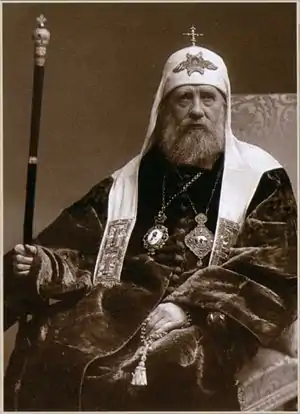Koukoulion
The koukoulion (Slavonic: kukol) is a traditional headdress worn by monks of the highest degree in Eastern Christianity. (See Degrees of Eastern Orthodox monasticism.)


From the 17th century, following the reforms of Patriarch Nikon, the upper vesture worn by monks of the Great Schema (skhimonakh) is in the form of a pointed hood with two long lappets which cover the back and breast. It is black in color, and embroidered with crosses, six-winged seraphim, and the text of the Trisagion. It is worn above the mandyas (monastic mantle), and is the same for both monks and nuns. In the context of monastic vows, it is called the koukoulion of kindliness, and the helmet of salvation. The koukoulion replaces the klobuk which is worn by the monastics of lower ranks.
The Patriarch of Moscow and all Russia wears a white koukoulion with a "Zion", a stiffened point topped by a cross. He wears this ex officio, whether or not he has been tonsured into the Great Schema. Koukoulia are also worn by the primates of certain other Orthodox churches, for example the Catholicos-Patriarch of All Georgia.

Josyf Slipyj, Major Archbishop of the Ukrainian Greek Catholic Church, wore a red koukoulian, when made a cardinal of the Catholic Church at the consistory of 1965.
References
| Wikimedia Commons has media related to Koukoulion. |
- Philippi, Dieter (2009). Sammlung Philippi – Kopfbedeckungen in Glaube, Religion und Spiritualität,. St. Benno Verlag, Leipzig. ISBN 978-3-7462-2800-6.